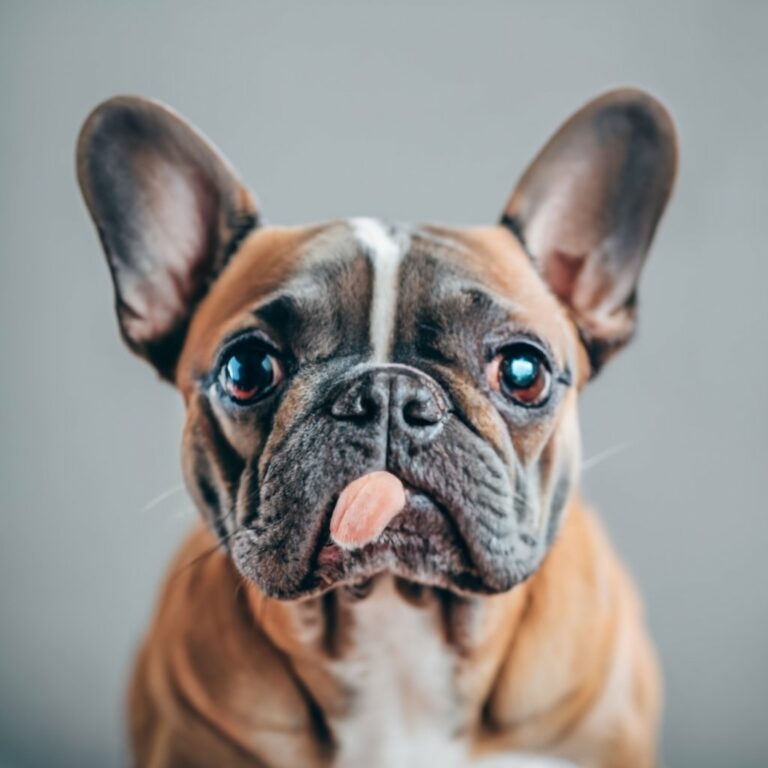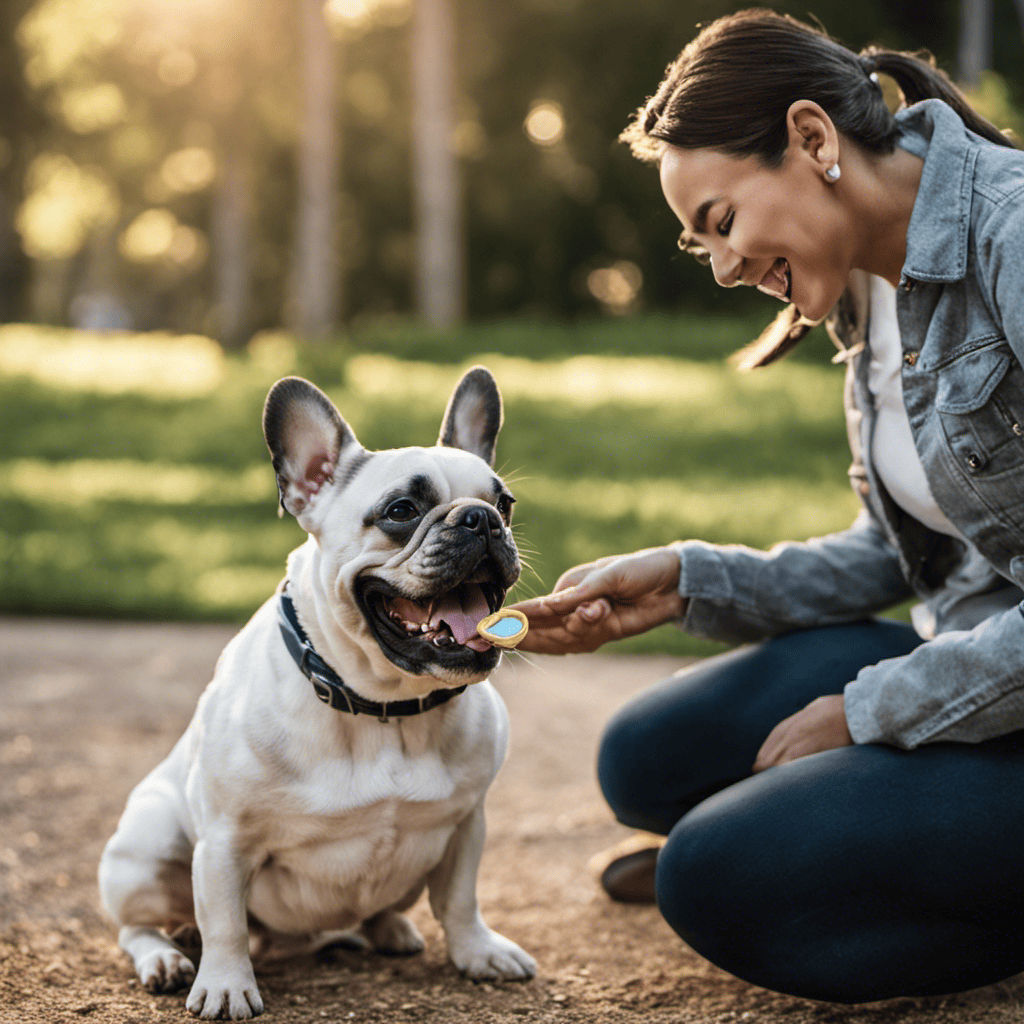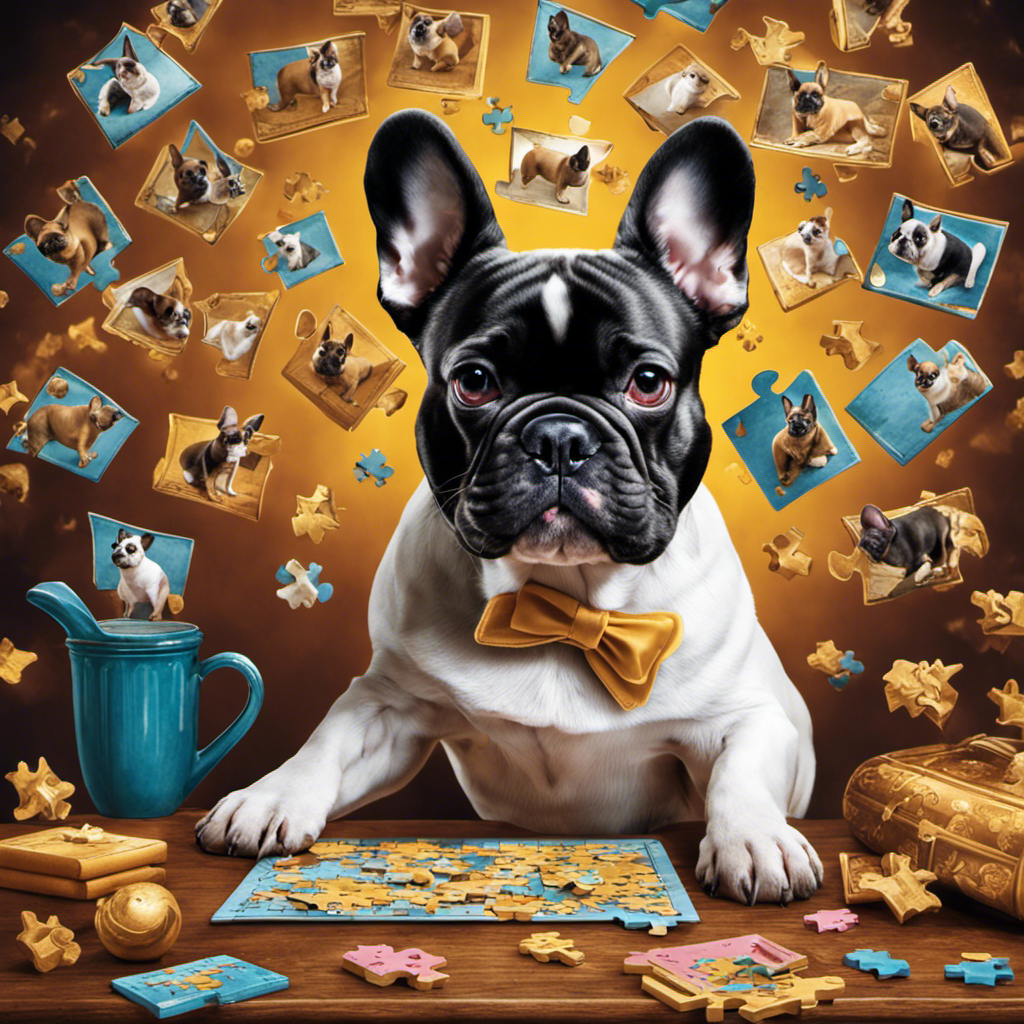I’ve discovered the secret to training French Bulldogs with positive reinforcement techniques.
In this article, I’ll share my knowledge on choosing the right rewards, creating a positive training environment, and teaching basic commands.
We’ll also tackle problem-solving through positive reinforcement and take your training to the next level.
With these techniques, you’ll be able to build a strong bond with your furry friend and achieve the desired behavior without resorting to punishment.
Get ready to revolutionize your training approach!
Key Takeaways

- Positive reinforcement is an effective method for training French Bulldogs.
- Choosing the right rewards, such as high-value treats, is important for motivating the dog.
- Consistency, patience, and celebration of small victories are crucial for creating a positive training environment.
- Teaching basic commands through positive reinforcement involves breaking down commands into smaller steps and practicing consistency and repetition.
Understanding Positive Reinforcement Training

I’m currently learning about positive reinforcement training and how it can be used to effectively train French Bulldogs. Understanding reinforcement schedules and the role of positive reinforcement in behavior modification is key to successful training.
Positive reinforcement is a technique that involves rewarding desired behaviors to encourage their repetition. It focuses on rewarding good behavior rather than punishing unwanted behavior. This approach has shown to be highly effective in training dogs, including French Bulldogs.
One important aspect to understand is reinforcement schedules. There are different types of reinforcement schedules that can be applied during training. For example, a continuous reinforcement schedule involves rewarding the desired behavior every time it occurs. This can be useful during the initial stages of training when you want to reinforce a specific behavior consistently. On the other hand, a variable reinforcement schedule involves rewarding the behavior intermittently. This helps to maintain the learned behavior over time and prevent dependence on constant rewards.
Positive reinforcement plays a crucial role in behavior modification. By associating desired behaviors with rewards, dogs learn to repeat those behaviors. This leads to a positive and lasting change in their behavior. It helps in building a strong bond and trust between the trainer and the dog, creating a positive training experience.
Choosing the Right Rewards for Your French Bulldog


When it comes to choosing the right rewards for your French Bulldog, it’s important to consider their treat preferences, the variety of reward options available, and the timing of reward delivery.
Every dog has different tastes and preferences, so it’s essential to find treats that truly motivate them during training sessions.
Additionally, offering a variety of rewards can help keep your dog engaged and excited to learn.
Lastly, timing is crucial in order to reinforce the desired behavior effectively.
Treat Preferences for Training
I’ve found that using high-value treats like chicken or cheese is the most effective way to train my French Bulldog. French Bulldogs are known for being food motivated, so using dog-friendly treats as motivational rewards during training sessions has been incredibly successful for me. Not only do these treats keep my dog engaged and focused, but they also serve as a positive reinforcement for desired behaviors.
Here is a table showcasing some popular dog-friendly treats that can be used for training:
| Treat Name | Protein Source | Texture | Size |
|---|---|---|---|
| Chicken Jerky | Chicken | Chewy | Small |
| Cheese | Dairy | Soft | Medium |
| Peanut Butter Kong | Peanuts | Sticky | Large |
| Salmon Treats | Salmon | Crunchy | Small |
Variety of Reward Options
My French Bulldog’s variety of reward options include treats, praise, and playtime.
When it comes to training, using different types of toys as rewards can be incredibly effective. French Bulldogs are known for their playful nature, so incorporating playtime as a reward can be a great motivator. Interactive toys, such as puzzle toys or treat-dispensing toys, can engage their natural instincts and provide mental stimulation. These toys not only keep them entertained, but also serve as a positive reinforcement for good behavior.
Timing of Reward Delivery
I believe that timing plays a crucial role in the effectiveness of reward delivery during French Bulldog training sessions. When it comes to training our furry friends, timing is everything. Effective timing can make or break a training session, and it directly affects the dog’s understanding and motivation. Here are three reasons why timing is so important:
-
Instant Gratification: Dogs are creatures of the moment. They need immediate feedback to associate the behavior with the reward. Delayed rewards can confuse and demotivate them.
-
Clear Communication: Proper timing ensures that the reward is delivered at the exact moment the desired behavior occurs. This way, the dog understands what they’re being rewarded for, reinforcing the correct behavior.
-
Emotional Connection: Timely rewards create a positive emotional experience for the dog. They feel the joy and satisfaction of a job well done, strengthening the bond between the trainer and the French Bulldog.
Creating a Positive Training Environment

Training my French Bulldog in a positive environment ensures their success and happiness. Creating a positive training environment is essential for building trust and fostering a strong bond with your furry friend. By using positive reinforcement techniques, such as rewards and praise, we can encourage desired behaviors and discourage unwanted ones.
In a positive training environment, it is important to focus on the following key elements:
| Key Elements | Description |
|---|---|
| Consistency | Providing clear and consistent cues and expectations. |
| Patience | Allowing your dog time to learn and understand commands. |
| Encouragement | Celebrating small victories and progress along the way. |
| Fun and Engagement | Making training sessions enjoyable and interactive. |
| Trust and Respect | Building a foundation of trust and respect between dog and owner. |
By incorporating these elements into your training routine, you can create an environment that promotes positive learning experiences for your French Bulldog. Positive reinforcement, such as treats, toys, and verbal praise, helps reinforce desired behaviors and strengthens the bond between you and your dog.
Teaching Basic Commands Through Positive Reinforcement

Teaching basic commands through positive reinforcement is an effective and humane training method that I highly recommend.
By using rewards such as treats or praise, you can motivate your French Bulldog to learn and obey commands like sit, stay, and come.
Consistency in training and building strong associations between commands and rewards will help your dog understand what’s expected of them and reinforce their good behavior.
Rewards for Good Behavior
Using treats as rewards is an effective way to reinforce good behavior during training sessions. Not only does it provide motivation for your French Bulldog, but it also strengthens the bond between you and your furry friend. Here are three emotional benefits of using treats as rewards:
-
Increased confidence: When your French Bulldog successfully learns a new trick and receives a treat, it boosts their confidence, making them more eager to learn and try new things.
-
Trust and connection: By rewarding good behavior with treats, you establish a positive association between training and rewards. This helps build trust and a stronger bond between you and your dog.
-
Joy and excitement: Seeing the happiness and excitement in your French Bulldog’s eyes when they receive a treat for their good behavior brings immense joy to both of you, creating a positive training experience.
Consistency in Training
I find that maintaining a consistent routine and utilizing positive reinforcement greatly improves my French Bulldog’s response to commands. Consistency is key when it comes to training any dog, and French Bulldogs are no exception. By reinforcing good behavior consistently, my furry friend learns what’s expected of him and becomes more responsive to my commands.
I make sure to establish a positive training routine that includes regular exercise, mental stimulation, and rewards for good behavior. This not only keeps my French Bulldog engaged and motivated, but also strengthens our bond. Positive reinforcement techniques, such as treats, praise, and playtime, make the training process enjoyable for both of us.
With a consistent routine and positive reinforcement, my French Bulldog has become a well-behaved and obedient companion.
Building Strong Associations
During training sessions, I often reinforce basic commands with positive reinforcement techniques like treats and praise. This approach not only helps me establish trust with my French Bulldog, but it also allows me to overcome any fear and anxiety they may have. Positive reinforcement creates a positive association between the desired behavior and the reward, making training sessions enjoyable and effective.
By rewarding good behavior, I can build a strong bond with my dog, fostering a sense of trust and loyalty.
Overcoming fear and anxiety is crucial for a French Bulldog’s overall well-being and happiness. Positive reinforcement helps them feel safe and secure, boosting their confidence.
Positive reinforcement techniques can also help address any behavioral issues that arise, such as separation anxiety or aggression. By using rewards and praise, I can redirect their behavior and encourage more desirable actions.
Transition: With a strong foundation of trust and positive reinforcement, problem solving becomes easier and more effective.
Problem Solving With Positive Reinforcement

Fortunately, positive reinforcement techniques have proven to be highly effective in problem solving with French Bulldogs. When it comes to training our furry friends, it’s important to focus on positive reinforcement rather than punishment. This approach not only helps in solving behavioral issues but also strengthens the bond between us and our French Bulldogs.
One of the key problem solving techniques is to identify the root cause of the issue. Is your French Bulldog displaying aggressive behavior? Are they having trouble with potty training? Understanding the underlying cause will help in developing a targeted approach to address the problem.
Once the issue is identified, troubleshooting tips can be implemented. For instance, if your French Bulldog is exhibiting destructive behavior, providing them with appropriate toys and redirecting their attention can help redirect their energy in a positive way. Similarly, if they’re struggling with separation anxiety, gradually increasing the time apart and rewarding calm behavior can help alleviate their distress.
Remember, consistency is the key. Positive reinforcement requires patience and repetition. Celebrate small victories and reward your French Bulldog with treats, praise, or playtime when they exhibit desired behaviors. This will motivate them to continue behaving positively and will make the training process more enjoyable for both of you.
Taking Positive Reinforcement Training to the Next Level

To take positive reinforcement training to the next level, incorporating clicker training can be highly effective in reinforcing desired behaviors. Clicker training is an advanced technique in positive reinforcement training that involves using a small handheld device that makes a distinct clicking sound. This sound serves as a signal to the dog that they’ve performed the desired behavior correctly, and they’ll be rewarded accordingly.
Here are three reasons why clicker training can take positive reinforcement to new levels:
-
Enhanced Communication: The clicker provides a clear and precise marker for the dog, making it easier for them to understand what behavior is being rewarded. This improves communication between the trainer and the dog, leading to faster and more effective training.
-
Increased Motivation: The sound of the clicker becomes a highly valued reward for the dog, motivating them to perform the desired behavior repeatedly. This increased motivation can help in training complex behaviors and overcoming challenges.
-
Fine-tuned Timing: Clicker training requires the trainer to have precise timing, as the click must occur immediately after the desired behavior. This teaches the trainer to be more observant and responsive, resulting in a more efficient and successful training process.
Incorporating clicker training into positive reinforcement training can truly elevate the training experience, taking it to new heights and opening doors to advanced techniques in positive reinforcement training.
Frequently Asked Questions
How Do I Deal With My French Bulldog’s Separation Anxiety Through Positive Reinforcement Training?
To deal with my French Bulldog’s separation anxiety, I create a positive reinforcement plan. I use techniques to gradually desensitize my dog to being alone. It’s important to be patient and consistent in training.
Can Positive Reinforcement Training Be Used to Stop My French Bulldog From Jumping on People?
Positive reinforcement training has proven effective in teaching my French Bulldog to stay off furniture and walk calmly on a leash. It can also be used to stop them from jumping on people, promoting positive interactions.
What Are Some Tips for Successfully House Training My French Bulldog Using Positive Reinforcement Techniques?
To successfully house train a French Bulldog using positive reinforcement techniques, start by establishing a consistent routine, rewarding good behavior with treats or praise, and redirecting accidents without punishment. This approach promotes learning and strengthens the bond between you and your dog.
How Can I Use Positive Reinforcement Training to Address My French Bulldog’s Excessive Barking?
To address my French Bulldog’s excessive barking, I can use positive reinforcement training techniques. Effective ways include using rewards and praise when my dog remains quiet, and redirecting their attention to more appropriate behaviors.
Can Positive Reinforcement Training Be Used to Help My French Bulldog Overcome Fear or Aggression Issues?
Using positive reinforcement training techniques can help my French Bulldog overcome fear or aggression issues. By rewarding desired behaviors and redirecting negative ones, I can create a safe and positive environment for my dog to learn and grow.
Conclusion
In conclusion, positive reinforcement training is an effective and humane method for training French Bulldogs. By understanding how to use rewards and creating a positive training environment, owners can teach their dogs basic commands and problem solve through positive reinforcement.
Taking this training to the next level can lead to a stronger bond between owner and dog, much like a blossoming flower opening up to the sun.
So, let’s embrace the power of positive reinforcement and watch our French Bulldogs bloom into well-behaved and happy companions.
Hi, I’m Alex! At FrenchyFab.com, I share my expertise and love for French Bulldogs. Dive in for top-notch grooming, nutrition, and health care tips to keep your Frenchie thriving.



